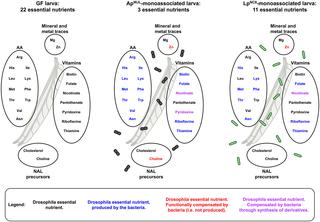PLOS Biology ( IF 7.8 ) Pub Date : 2020-03-20 , DOI: 10.1371/journal.pbio.3000681 Jessika Consuegra 1 , Théodore Grenier 1 , Patrice Baa-Puyoulet 2 , Isabelle Rahioui 2 , Houssam Akherraz 1 , Hugo Gervais 1 , Nicolas Parisot 2 , Pedro da Silva 2 , Hubert Charles 2 , Federica Calevro 2 , François Leulier 1

|
The interplay between nutrition and the microbial communities colonizing the gastrointestinal tract (i.e., gut microbiota) determines juvenile growth trajectory. Nutritional deficiencies trigger developmental delays, and an immature gut microbiota is a hallmark of pathologies related to childhood undernutrition. However, how host-associated bacteria modulate the impact of nutrition on juvenile growth remains elusive. Here, using gnotobiotic Drosophila melanogaster larvae independently associated with Acetobacter pomorumWJL (ApWJL) and Lactobacillus plantarumNC8 (LpNC8), 2 model Drosophila-associated bacteria, we performed a large-scale, systematic nutritional screen based on larval growth in 40 different and precisely controlled nutritional environments. We combined these results with genome-based metabolic network reconstruction to define the biosynthetic capacities of Drosophila germ-free (GF) larvae and its 2 bacterial partners. We first established that ApWJL and LpNC8 differentially fulfill the nutritional requirements of the ex-GF larvae and parsed such difference down to individual amino acids, vitamins, other micronutrients, and trace metals. We found that Drosophila-associated bacteria not only fortify the host’s diet with essential nutrients but, in specific instances, functionally compensate for host auxotrophies by either providing a metabolic intermediate or nutrient derivative to the host or by uptaking, concentrating, and delivering contaminant traces of micronutrients. Our systematic work reveals that beyond the molecular dialogue engaged between the host and its bacterial partners, Drosophila and its associated bacteria establish an integrated nutritional network relying on nutrient provision and utilization.
中文翻译:

果蝇相关细菌在幼年期生长过程中不同地影响了宿主的营养需求。
营养与定居在胃肠道的微生物群落(即肠道菌群)之间的相互作用决定了幼虫的生长轨迹。营养不足会导致发育迟缓,肠道菌群的不成熟是与儿童营养不良有关的病理学的标志。然而,寄主相关细菌如何调节营养对青少年生长的影响仍然不清楚。在这里,使用与产气醋杆菌WJL(Ap WJL)和植物乳杆菌NC8(Lp NC8)独立相关的生果蝇果蝇幼虫,这两种果蝇模型-相关细菌,我们基于40种不同且精确控制的营养环境中幼虫的生长进行了大规模,系统的营养筛选。我们将这些结果与基于基因组的代谢网络重建相结合,以定义果蝇无菌(GF)幼虫及其2个细菌伴侣的生物合成能力。我们首先确定Ap WJL和Lp NC8差异地满足了前GF幼虫的营养要求,并将这种差异解析为单个氨基酸,维生素,其他微量营养素和微量金属。我们发现果蝇-相关细菌不仅通过必需营养素强化宿主的饮食,而且在特定情况下,通过向宿主提供代谢中间产物或营养素衍生物或通过摄取,浓缩和传递微量微量营养素来在功能上补偿宿主营养缺陷。我们的系统工作表明,除了宿主与细菌伙伴之间的分子对话之外,果蝇及其相关细菌还建立了依赖于营养物提供和利用的综合营养网络。











































 京公网安备 11010802027423号
京公网安备 11010802027423号